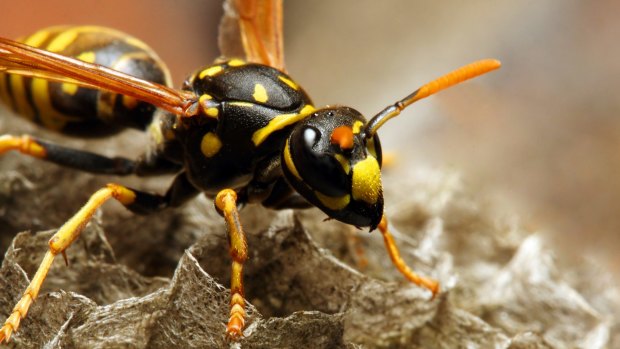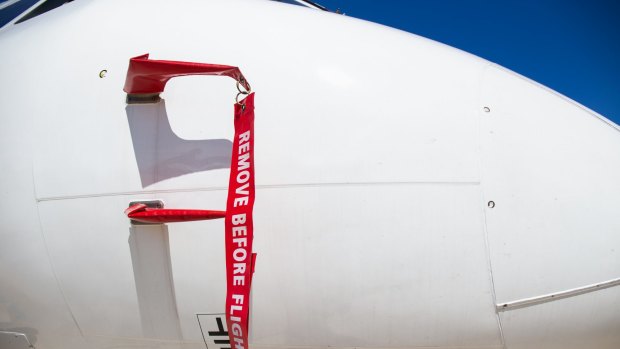This was published 1 year ago
How nature can cause plane crashes: How wasps, birds and volcanoes are threats to airlines
By Michael Gebicki

Wasps can build nests in crucial aircraft instruments.Credit: iStock
Baggage delays, flight cancellations, pilots with COVID, drones around airports – there are plenty of ways your flight can be disrupted, and mother nature has her own special way of bringing trouble to the flying experience. Especially through interventions from the animal kingdom.
Deer, reindeer, sheep and kangaroos have all been known to wander onto runways. In 2020 an Alaska Airlines Boeing 737 hit a bear while landing at Yakutat Airport in south-east Alaska. Weirder still, another AA aircraft departing from Juneau, the state capital, was clobbered by a fish. An eagle released its catch as the aircraft passed below, striking it aft of the cockpit window. That's Alaska for you, and although we don't have bears, right here there are plenty more ways nature can mess with your flight.
A mud-building wasp can bring down an aircraft

A cover on the pitot tubs of a plane.Credit: iStock
Pitot tubes are narrow metal cylinders that measure an aircraft's airspeed. In effect they're the aircraft's speedometer, and they matter. An aircraft with insufficient airspeed is at risk of stalling, while an aircraft travelling too quickly risks running out of fuel, or overshooting the runway.
Pitot tubes are mounted on the outside of the aircraft, usually beneath the cockpit or along the wing, and they're an ideal nest for keyhole wasps, an invasive species native to Central and South America that has found a happy home in Australia.
The problem is acute at Brisbane Airport, where ground crews have taken to covering pitot tubes while the aircraft is stationary. Even on a brief turnaround, keyhole wasps have been known to move in and start importing mud to build a nest, and that can cause the pitot tube to malfunction.
It's believed that a keyhole wasp nest caused the crash of a Boeing 757 operated by Birgenair after it departed from Puerto Plata in the Dominican Republic in 1996. One of the aircraft's three pitot tubes was blocked, yet air trapped inside the tube expanded as pressure increased when the aircraft climbed, causing the sensors to over indicate the airspeed by almost 300 km/h. Based on that false reading, the autopilot reduced speed and lifted the nose, the aircraft stalled and crashed into the sea with the loss of everyone on board.
Bird strikes
In the USA alone, the FAA records more than 10,000 bird strikes on aircraft every year. Worldwide, they cost the aviation industry over $1.5 billion per annum. In 2008 a Ryanair flight from Frankfurt to Rome was hit by multiple bird strikes while landing, causing so much damage that the eight-month old Boeing 737 was written off. The most famous bird strike of all occurred in January 2009 when a US Airways Airbus A320 ran into a flock of geese shortly after take-off from New York's La Guardia Airport, causing both engines to fail and a spectacular landing on the city's Hudson River.
Airports employ various bird-scaring methods, such as propane-fired cannons, the same as those used to scare birds from crops. At Utah's Salt Lake City International Airport, pigs are used to destroy the nesting habitat of the airport's California gulls and border collies are used as bird-chasers at Florida's Southwest International Airport. Some of the world's busiest airports have advanced radar systems that detect bird flocks, and aircraft manufacturers stress test-their aircraft against bird impacts.
True story – Canada's Aerospace Research Centre has chicken cannons, long-barrelled guns that fire bird carcasses at aircraft windows, fuselages and even rotating engine blades to test their vulnerability. Using compressed air, the cannons can fire a dead chicken at speeds exceeding 1000 km/h. In the 1970s, the cockpits of Boeing's 757 and 767 were re-engineered after a 1.8kg chicken fired at 670 km/h punched a hole in the aircraft's skin.
Volcanic ash
Erupting volcanoes cough up clouds of fine ash that can clog aircraft engines, even at a cruise altitude of 11,000 metres. It's a lesson learned the hard way.
In 1982 a British Airways Boeing 747 was en route from Kuala Lumpur to Perth when it flew through a cloud of volcanic ash spewed from the eruption of Mount Galunggung, south-east of Jakarta. Within a couple of minutes all four engines failed. The crew put the aircraft into a glide, with the intention of making a risky water landing if the altitude was insufficient to clear the 3500-metre mountains along the south coast of Java, but at 4100 metres they were able to restart one of the engines, followed by the other three. The aircraft then made a safe landing at Jakarta, although the windscreen was opaque, having been sandblasted by the ash cloud, requiring a difficult instrument landing with no way of measuring altitude.
A subsequent investigation found that the ash cloud failed to register on the weather radar, which was designed to detect moisture in clouds.
These days authorities move fast to close airspace in the vicinity of volcanic eruptions. In 2010 Europe endured a month of air travel chaos when the Icelandic volcano Eyjajallajokul erupted, sending a plume of volcanic ash more than nine kilometres into the sky. In 2018 thousands of Australians were stranded in Bali when Mount Agung erupted and the island closed its international airport.
Sign up for the Traveller newsletter
The latest travel news, tips and inspiration delivered to your inbox. Sign up now.